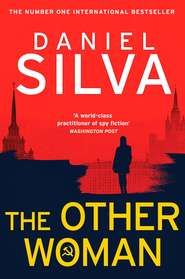По всем вопросам обращайтесь на: info@litportal.ru
(©) 2003-2024.
✖
The Black Widow
Настройки чтения
Размер шрифта
Высота строк
Поля
Chapter 59: Key Bridge Marriott (#litres_trial_promo)
Chapter 60: The White House (#litres_trial_promo)
Chapter 61: The Lincoln Memorial (#litres_trial_promo)
Chapter 62: Liberty Crossing, Virginia (#litres_trial_promo)
Chapter 63: Georgetown (#litres_trial_promo)
Chapter 64: Café Milano, Georgetown (#litres_trial_promo)
Chapter 65: Wisconsin Avenue, Georgetown (#litres_trial_promo)
Chapter 66: Wisconsin Avenue, Georgetown (#litres_trial_promo)
Chapter 67: Café Milano, Georgetown (#litres_trial_promo)
Chapter 68: King Saul Boulevard, Tel Aviv (#litres_trial_promo)
Chapter 69: Hume, Virginia (#litres_trial_promo)
Chapter 70: Arlington, Virginia (#litres_trial_promo)
Chapter 71: Hume, Virginia (#litres_trial_promo)
Chapter 72: Arlington, Virginia (#litres_trial_promo)
Chapter 73: Hume, Virginia (#litres_trial_promo)
Chapter 74: Hume, Virginia (#litres_trial_promo)
Part Four (#litres_trial_promo)
Chapter 75: Washington—Jerusalem (#litres_trial_promo)
Chapter 76: Nahalal, Israel (#litres_trial_promo)
Chapter 77: Petah Tikva, Israel (#litres_trial_promo)
Chapter 78: Jerusalem (#litres_trial_promo)
Chapter 79: Jerusalem—Tiberias (#litres_trial_promo)
Chapter 80: Bethnal Green, London (#litres_trial_promo)
Author’s Note (#litres_trial_promo)
Acknowledgments (#litres_trial_promo)
About the Author (#litres_trial_promo)
Also Written by Daniel Silva (#litres_trial_promo)
About the Publisher (#litres_trial_promo)
FOREWORD (#u22dd4819-ba07-5eee-bd80-f28ab77d73ca)
I COMMENCED WORK ON THIS NOVEL before the Islamic terrorist group known as ISIS carried out a wave of shootings and bombings in Paris and Brussels that left more than 160 people dead. After briefly considering setting aside the typescript, I chose to complete it as originally conceived, as though the tragic events had not yet occurred in the imaginary world where my characters live and work. The similarities between the real and fictitious attacks, including the links to the Brussels district of Molenbeek, are entirely coincidental. I take no pride in my prescience. I only wish that the murderous, millenarian terrorism of the Islamic State lived solely on the pages of this story.
(#u22dd4819-ba07-5eee-bd80-f28ab77d73ca)
1 (#u22dd4819-ba07-5eee-bd80-f28ab77d73ca)
THE MARAIS, PARIS (#u22dd4819-ba07-5eee-bd80-f28ab77d73ca)
IT WAS TOULOUSE THAT WOULD prove to be Hannah Weinberg’s undoing. That night she telephoned Alain Lambert, a contact at the Interior Ministry, and told him that this time something would have to be done. Alain promised a swift response. It would be bold, he assured Hannah, boldness being the default response of a fonctionnaire when in reality he planned to do nothing at all. The following morning the minister himself paid a visit to the site of the attack and issued a vague call for “dialogue and healing.” To the parents of the three victims he offered only regrets. “We will do better,” he said before returning hastily to Paris. “We must.”
They were twelve years of age, the victims, two boys and a girl, all Jewish, though the French media neglected to mention their religion in the first reports. Nor did they bother to point out that the six attackers were Muslim, only that they were youths who resided in a suburb, a banlieue, east of the city center. The description of the attack was vague to the point of inaccuracy. According to French radio, an altercation of some sort had occurred outside a patisserie. Three were injured, one seriously. The police were investigating. No arrests had been made.
In truth, it had not been an altercation but a well-planned ambush. And the attackers were not youths, they were men in their early twenties who had ventured into the center of Toulouse in search of Jews to harm. That their victims were children seemed to trouble them not. The two young boys were kicked, spat upon, and then beaten bloody. The girl was pinned to the pavement and her face slashed with a knife. Before fleeing, the six attackers turned to a group of stunned bystanders and shouted, “Khaybar, Khaybar, ya-Yahud!” Though the witnesses did not know it, the Arabic chant was a reference to the seventh-century Muslim conquest of a Jewish oasis near the holy city of Medina. Its message was unmistakable. The armies of Muhammad, the six men were saying, were coming for the Jews of France.
Regrettably, the attack in Toulouse was not without precedent or ample warning. France was presently in the grip of the worst spasm of violence against Jews since the Holocaust. Synagogues had been firebombed, gravestones toppled, shops looted, homes vandalized and marked with threatening graffiti. In all, there had been more than four thousand documented attacks during the past year alone, each carefully recorded and investigated by Hannah and her team at the Isaac Weinberg Center for the Study of Anti-Semitism in France.
Named for Hannah’s paternal grandfather, the center had opened its doors under heavy security ten years earlier. It was now the most respected such institution in France, and Hannah Weinberg was regarded as the foremost chronicler of the country’s new wave of anti-Semitism. Her supporters referred to her as a “memory militant,” a woman who would stop at nothing to pressure France into protecting its besieged Jewish minority. Her detractors were far less charitable. Consequently, Hannah had long ago stopped reading the things that were written about her in the press or in the sewers of the Internet.
The Weinberg Center stood on the rue des Rosiers, the most prominent street in the city’s most visible Jewish neighborhood. Hannah’s apartment was around the corner on the rue Pavée. The nameplate on the intercom read MME BERTRAND, one of the few steps she took to safeguard her security. She resided in the flat alone, surrounded by the possessions of three generations of her family, including a modest collection of paintings and several hundred antique lunettes, her secret passion. At fifty-five, she was unmarried and childless. Occasionally, when work permitted, she allowed herself a lover. Alain Lambert, her contact at the Interior Ministry, had once been a pleasant distraction during a particularly tense period of anti-Jewish incidents. He rang Hannah at home late after his master’s visit to Toulouse.
“So much for boldness,” she said acidly. “He should be ashamed of himself.”
“We did the best we could.”
“Your best wasn’t good enough.”
“It’s better not to throw oil on the fire at a time like this.”
“That’s the same thing they said in the summer of nineteen forty-two.”
“Let’s not get overly emotional.”
“You leave me no choice but to issue a statement, Alain.”
“Choose your words carefully. We’re the only ones standing between you and them.”
Hannah hung up the phone. Then she opened the top drawer of the writing desk and removed a single key. It unlocked a door at the end of the hall. Behind it was the room of a child, Hannah’s room, frozen in time. A four-poster bed with a lace canopy. Shelves stacked with stuffed animals and toys. A faded pinup of a heartthrob American actor. And hanging above the French provincial dresser, invisible in the darkness, was a painting by Vincent van Gogh. Marguerite Gachet at Her Dressing Table . . . Hannah trailed a fingertip over the brushstrokes and thought of the man who had carried out the painting’s one and only restoration. How would he respond at a time like this? No, she thought, smiling. That wouldn’t do.
She climbed into her childhood bed and, much to her surprise, fell into a dreamless sleep. And when she woke she had settled on a plan.
For the better part of the next week, Hannah and her team toiled under conditions of strict operational security. Potential participants were quietly approached, arms were twisted, donors were tapped. Two of Hannah’s most reliable sources of funding demurred, for like the minister of the interior they thought it better to not jeter de l’huile sur le feu—throw oil on the fire. To make up for the shortfall, Hannah had no choice but to dip into her personal finances, which were considerable. This, too, was fodder for her enemies.











